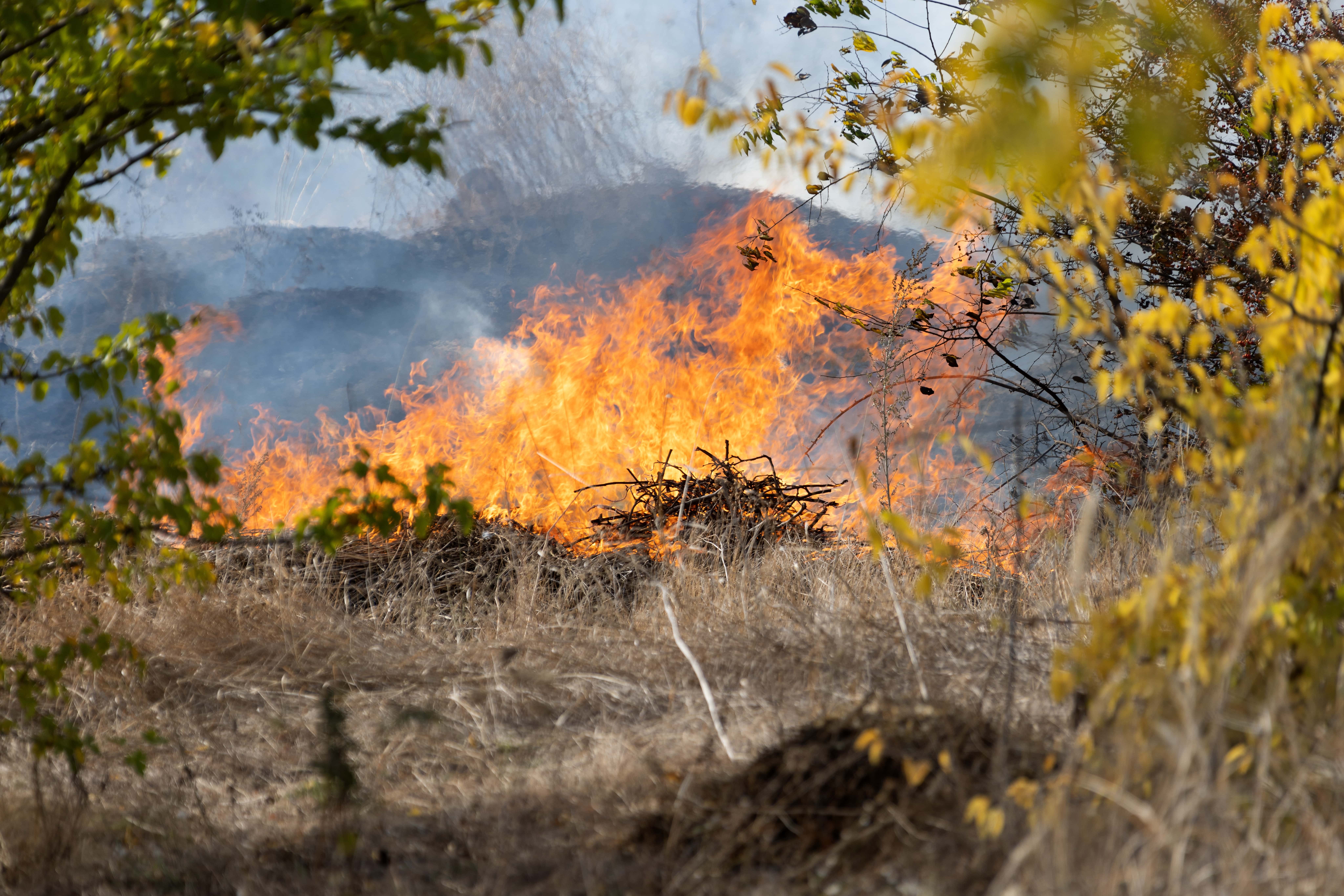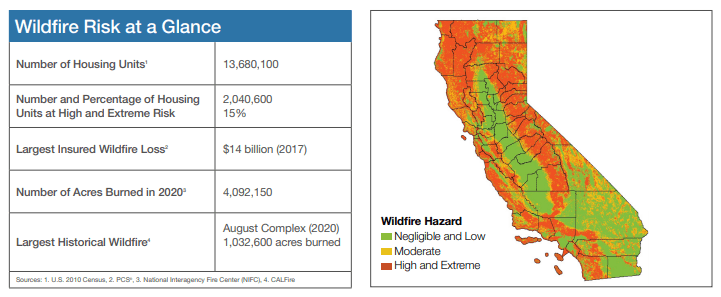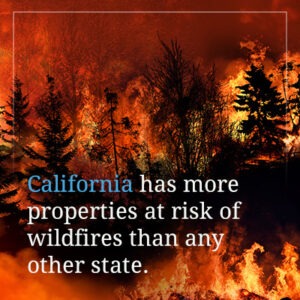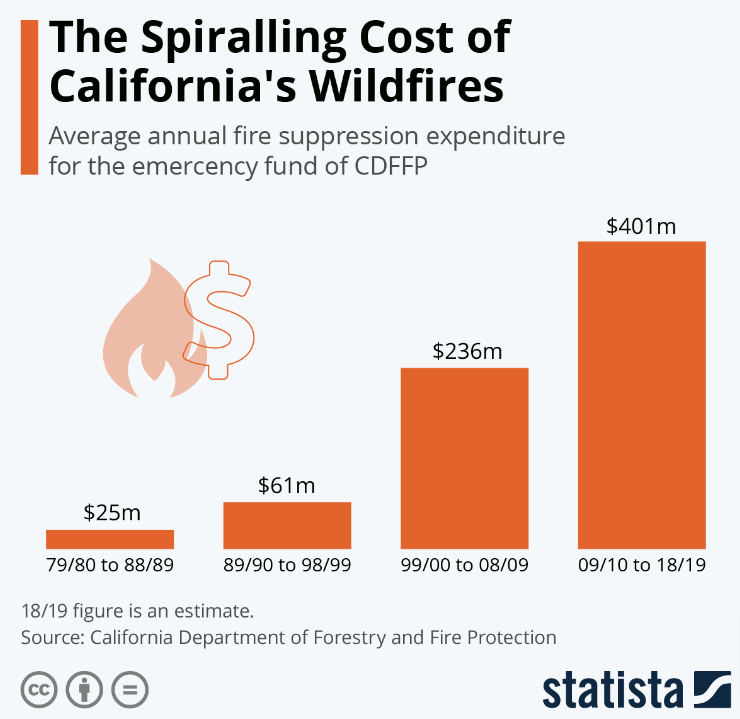
California experiences devastating wildfires every so often that leave a trail of damaged property, injuries, health complications due to environmental pollution, and sometimes fatalities. According to the U.S. Environmental Protection Agency, smoke exposure can lead to several health issues, such as bronchitis, reduced lung function, eye and respiratory tract irritation, and premature death, among other conditions. While most wildfires are caused by human activity, the Golden State’s weather situation (drought and strong winds) contributes largely to the spread of the infernos.
Whether you have been affected by wildfires started by human negligence, such as a power company failing to maintain vegetation along powerlines, natural causes such as lightning, or even arson, you can file a lawsuit to receive compensation for the losses incurred.
Facts About California Wildfires
California sees more wildfires than any other state, mostly due to the dry climate in the region. A wildfire requires only three elements to ignite – fuel, air, and a heat source. Increased dry vegetation, especially during dry and windy months, increases the risk of wildfires spreading. All it takes is a heat source, such as lightning strikes, cigarette filters, or campfires, to fuel an inferno.

Here is an overview of important facts about California Wildfires.
- California is the state most at risk of wildfire
According to a 2021 report by Verisk on states at wildfire risks, California was leading with an estimated 2,040,600 properties at risk. The second and third most at-risk states are Texas and Colorado, with 717,800 and 373,900 properties at risk, respectively.
- California had the highest number of wildfires in 2021
California experienced the highest number of wildfires in the United States in 2021, and the UN Environment Programme predicts a 50% rise in global wildfires by 2100.
According to Statista, there were 9,280 wildfires, which burned over two million acres. Texas and North Carolina came second and third with 5,576 and 5,151 wildfires, respectively. The least affected states were Hawaii, which had one fire, and Delaware, with no incident.
 California fires are among the top ten costliest fires in the nation.
California fires are among the top ten costliest fires in the nation.
Examples include the Camp Fire, Tubbs Fire, Thomas Fire, and LNU Lightning Complex Fire. The Camp Fire had an estimated insured loss of $10.75 billion, the Tubbs Fire cost $9.56 billion, while the Thomas and LNU Lightning Complex fires cost $2.47 and $2.34 billion, respectively.
- Humans cause 90% of wildfires
Wildfires can start naturally, e.g., lightning strikes or lava. However, most wildfires in California and across the nation are started by humans. According to research, about 90% of the fires are human-related, with causes ranging from unattended campfires, downed power lines, discarded cigarette filters, arson, etc.
- Wildfires are a major cause of air pollution
Smoke and burning debris from wildfires deposit huge amounts of pollutants into the air, significantly affecting its quality. The pollutants are in the form of fine particles and gases, which, when inhaled, cause problems such as bronchitis, burning eyes, and allergies while aggravating existing conditions such as asthma. Also, pollution can lead to premature death in people with heart and lung diseases.
Having covered the background of the state’s wild infernos, let’s now look at the top fires based on the number of acres burned, starting with the most recent.
Dixie Fire – July 2021

The Dixie Fire started on July 13, 2021, and burned 963,309 acres across multiple counties before full containment. It got its name from Dixie Road, near where it started. According to the investigations, the fire was caused by PG&E power lines and was quickly fueled by the area’s shrubs, brush, and grass. The weather conditions – drought, dry weather, and strong winds – also played a huge part in the rapid spread of the fire.
The Dixie Fire ravaged the Lassen National Forest, Plumas National Forest, and Lassen Volcanic National Park and affected five counties, including Plumas, Butte, Shasta, Tehama, and Lassen counties. Impacted communities included Jonesville, Greenville, Butte Meadows, Williams Valley, Hunt Canyon, Janesville, Chester, Hwy 89 Corridor, and Warner Valley, among many others.
At full containment, the fire destroyed 1,329 structures within the affected communities and caused one fatality. The inferno released unhealthy amounts of smoke into the environment, affecting the air quality in California and neighboring states, including Utah and Colorado.
Creek Fire – September 2020
The Creek Fire was one of the many wildfires that burned across California in 2020. It started on September 4, 2020, and burned 379,895 acres before being contained towards the end of December 2020. The fire’s cause is undetermined. The fire affected the areas near Shaver Lake, San Joaquin River Canyon, Big Creek, Mammoth Pool, Huntington Lake, and Big Creek in Madera and Fresno counties.
Fueled by strong winds and drought-dried vegetation, the firestorm swept through hundreds of properties, destroying about 853 structures. There were no fatalities in the Creek Fire, but hundreds of residents had to be rescued by National Guard helicopters. Almost $200 million were spent on fire suppression efforts.
August Complex Fire – August 2020
The August Complex Fire started in mid-August 2020 and burned 1,032,648 acres before its containment four months later. Investigations established that the fire was caused by lightning, then fueled by brush, timber, and short grass in the areas affected. Counties impacted included Trinity, Glenn, Lake, Humboldt, Tehama, and Colusa counties.
So far, the August Complex Fire remains the largest fire in California, with the high winds and heat having heightened the challenge for firefighters, slowing down suppression efforts. Most of the fire was concentrated in Mendocino National Forest before spreading to the Six Rivers National Forest and Shasta Trinity National Forest. Communities around the forests were also affected, with 935 structures destroyed.
According to the reports, one person lost their life, and two others were seriously injured.
SCU Lightning Complex Fire – August 2020
The SCU Lightning Complex Fire was another August 2020 wildfire that started on the morning hours of the sixteenth day of the month. It was christened SCU, the abbreviation of the state’s Department of Forestry and Fire Protection, Santa Clara Unit.
Before complete containment, the fire had ravaged 396,624 acres in Alameda, Santa Clara, Contra Costa, Merced, San Joaquin, and Stanislaus counties. There were no fatalities, but six people sustained injuries. It also caused extensive property damage, with 222 structures having been destroyed.
LNU Lightning Complex Fire – August 2020
Also started in August 2020, the LNU Lightning Complex Fire was caused by lightning and arson. A series of thunderstorms sparked thousands of lightning strikes, which ignited the fires.
At the time of full containment, it had burned 363,220 acres in Sonoma, Napa, Colusa, Solano, Lake, and Yolo counties. The fire mostly burned in the hills surrounding the cities of Napa, Fairfield, and Vacaville and destroyed 1,491 structures. Five people got injured, and six lives were lost.
North Complex Fire – August 2020
The North Complex Fire was ignited by lightning in August 2020 and ravaged the California landscape until full containment in December 2020. The fire, mostly fueled by winds, affected the counties of Plumas, Yuba, and Butte, where it burned 318,935 acres.
It caused more than one hundred injuries, while about fifteen people lost their lives. The smoke from the enormous inferno affected the air quality, creating unhealthy conditions for the residents in the affected areas and beyond. There was also extensive destruction, with 2,352 structures destroyed.
Mendocino Complex Fire – July 2018
Mendocino Complex Fire broke out in July 2018 and affected Lake, Glenn, Colusa, and Mendocino counties. Two fire incidents combined to form the fire complex – the Ranch Fire and the River Fire. The Ranch Fire started from a hammer spark while a property owner was using the tool. The cause of the River Fire was undetermined.
The fire was active for several months and burned 459,123 acres. There were three injuries and one fatality. In addition, it destroyed 280 structures resulting in millions of dollars in losses. Communities affected included Upper Lake, Potter Valley, Big Valley Rancheria, Lucerne, Nice, Witter Springs, Saratoga Springs, and Lakeport, among others.
Thomas Fire – December 2017
The Thomas Fire broke out in December 2017 in Ventura and Santa Barbara counties, forcing over 100,000 residents out of their homes. The fire started after high winds caused power lines owned by Southern California Edison to come into contact with each other, sparking the inferno.
Fanned by the strong Santa Ana winds, the firestorm burned 281,893 acres. Two people died: a firefighter and an older woman who had an accident while fleeing the fire. In total, the fire destroyed 1,063 structures and damaged hundreds of others.
After the breakout, Southern California Edison shut down the power transmission system, affecting hundreds of thousands of customers. Dozens of school districts were also closed, including the University of California, Santa Barbara, which suspended classes due to air quality concerns and power outages.
When rain arrived in January, the absence of vegetation led to flash floods and mudslides, further damaging more homes and killing over 20 people.
Rush Fire – August 2012
The Rush Fire started in Lassen County in August 2012. It was caused by lightning and fueled by sagebrush, spreading further to Washoe County, Nevada. Though the fire burned 271,911 acres in California and 43,666 acres in Nevada, no structures were destroyed. There were also no casualties from the fire that was successfully contained by the end of August.
Cedar Fire – October 2003
The Cedar Fire broke out in October 2003 in Cleveland National Forest. The cause of the fire was human-related; according to media reports, a lost hunter started the fire to signal for help. Fanned by the Santa Ana winds, the inferno burned 273,246 acres in San Diego County, becoming the largest in California’s history at that time.
The Cedar Fire remains one of California’s deadliest and most destructive fires, having destroyed 2,820 structures and killed fifteen people while almost 100 others sustained injuries.
Cost of Wildfires
Wildfires are costly accidents – from suppression costs to insurance compensation for treatment for injured people, damaged property, relocation, business interruption, lost wages, wrongful death damages for deceased victims, etc.
Over the years, the cost of wildfires has continued to escalate in California. For instance, between 1999/2000 and 2008/2009, the California Department of Forestry and Fire Protection (CDFFP) spent $236 million in suppression efforts, while the decade between 2009/2010 and 2018/2019 saw a sharp increase in the expenditure to $401 million.
Insured losses have also been enormous, with California having witnessed the costliest fires in the nation. Examples include the Camp Fire, which had losses amounting to $10.75 billion; the Tubbs Fire at $9.56; the Woolsey Fire at $4.52; the Oakland Fire at $3.35 billion; and the Atlas Fire at $3.3 billion.
Compensation for wildfire victims includes losses for business interruption, evacuation costs, injuries, and wrongful death damages to a family that has lost a loved one. Wildfire lawsuits can be against an electric or utility company, private property owner, product manufacturer, government agency, a business/company, or an individual. A wildfire lawsuit lawyer can help you prepare the necessary evidence to prove the at-fault party’s liability and qualify for compensation.
Here is a summary of eligible damages;
- Property damage – The claim may include destruction or damage to the family home; damage to garage, fence, barn, shed, etc.; damage to personal possessions; damage to motor vehicles; damage to landscaping; damage to crops; death/injuries to livestock and pets; lost wages; or business losses due to interruptions.
- Physical injuries – You’re eligible for any damages resulting from physical injuries such as severe burns, disfigurement and scarring, permanent disability, eye and ear injuries, amputations, soft-tissue damage, etc. These may include costs for doctor visits, medications, surgery, rehabilitation and therapy, medical devices, and others.
- Pain and suffering damages – This covers compensation for emotional and psychological trauma, including physical pain from injuries, mental anguish, depression, disfigurement, post-traumatic stress disorder, inconvenience, loss of quality of life, and loss of consortium.
- Wrongful death damages – If you lost a loved one in the fire, you could seek compensation for burial expenses, loss of spousal companionship and consortium, loss of parental love and guidance, and family’s pain and suffering due to grief.
In addition, if the deceased was hospitalized before their death, you could claim their medical costs, plus compensation for their pain and suffering during the time.



